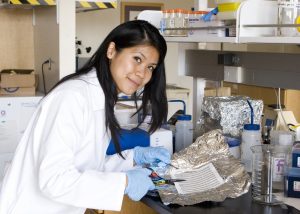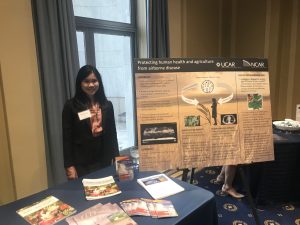July 6, 2018
Science & Agriculture: “Capitol”-izing Science
Posted by Timia Crisp
Authorship of this guest blog is credited to Linh Anh Cat, Next Generation Public Policy Fellow with University Corporation for Atmospheric Research (UCAR) and Ph.D. Candidate at University of California, Irvine.

Working with an air filter from the high volume sampler I use to collect microbes from the atmosphere.
As an ecologist in Washington, D.C., most of my conversations with staffers of members of Congress started with pointing out that deaths from fungal infections exceed that of malaria or tuberculosis. In addition, fungal disease destroys almost half of what we could grow in agricultural crops (a loss of $300 billion USD).1 Then, I would explain that airborne diseases are caused by fungi, bacteria, and virus that travel long distances (1000 km+) through wind movement. Plant pathogens land on and infect agricultural crops while human diseases are inhaled. To underscore this, fungicide resistance is increasing worldwide (Anderson et al. 2004).
My morbid conversation starter does have a silver lining – one that is only obvious once I spent my time brainstorming how to connect the results of my research to issues that impact society on a broader level. For example, we could be reducing economic losses and preventing deaths from fungal disease by forecasting when and where disease will strike. Almost half of all disease emergence is explained by weather acting on airborne disease.1 After connecting my research to broader issues, it was important to have an “ask” ready for staffers. Forecasting ability relies on solid Earth system science research and consistent data collection, especially in the atmospheric sciences.
Collecting consistent data to understand airborne disease movement as it relates to weather so we can forecast disease outbreaks is challenging because research funding is decided annually by Congress. When talking to staffers, I emphasized that a lapse in funding one year could lead to missing data, which is critical to developing a full understanding and reliable forecast for airborne disease.
My day-to-day as a scientist is researching spatio-temporal patterns of airborne dispersal of fungi, in particular, their functional diversity, or what services they contribute to an ecosystem. This ranges from increasing plant growth to breaking down dead matter to be recycled for other organisms to infecting other organisms. As an ecologist, I know that my discoveries are only helpful to the public if they can be linked with climate modeling that allows us to make better decisions on issues such as when and where to apply fungicide to prevent fungicide resistance from developing. Making these connections took time and

The author presenting at the House Earth & Space Science Caucus food security exhibition organized by AGU.
practice and I believe it’s a worthwhile endeavor for scientists to invest energy in linking their research to society. It would be incredibly useful for university professors and researchers to meet with their Representatives and Senators at district offices to show them the benefits of their research, which the representatives are likely to remember when they decide on budgets for our nation’s science agencies annually.
Through the Next Generation Public Policy Fellowship with University Corporation of Atmospheric Research (UCAR), I was able to formally dedicate two months to bringing my work at the bench to the Hill. UCAR manages the National Center for Atmospheric Research (NCAR), which works on improving prediction of the Earth system from day to day and decade to decade. In D.C., I spoke directly to staffers on both sides of the aisle and learned how to present issues based on the interests of the office I was visiting. I learned that connecting the results of my research to changes in quality of life of their constituents or economic losses in their district is how you grab their attention, especially since staffers spend most of their day in meetings. I focused on the agricultural issues rather than arguing the science behind climate change. Finding common ground first rather than getting caught up in the details was much more productive (and pleasant). I noticed that the more relate-able my stories were, the higher chance that there would be unexpected connections from another part of a staffers expertise or background that would make it more compelling to them personally.
At the end of my internship, I presented a policy brief on agriculture and human health impacts from airborne disease at the House Earth and Space Science Caucus exhibit on food security, organized by AGU. Over 170 people attended, including staffers and members of Congress from 63 House offices and 7 Senate offices. During my internship, I learned that my work is not only addressing a research gap, but also a policy gap.
Earth system sciences research covers a wide range of issues that affect the public. As scientists engaged with the public, we should use that to our advantage to urge Congress to continue funding science that benefits both their constituents and the United States as a whole.








